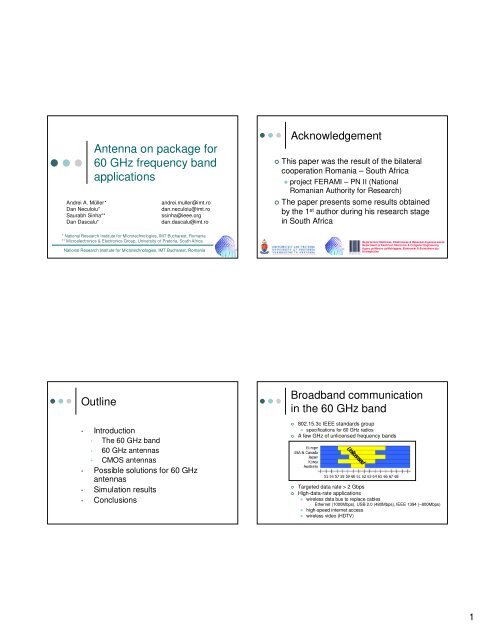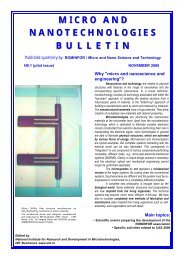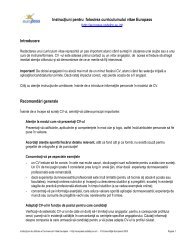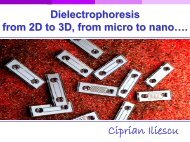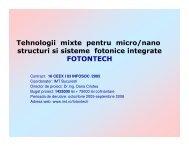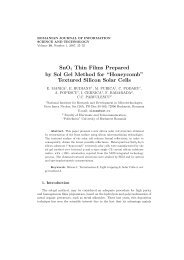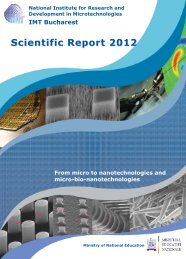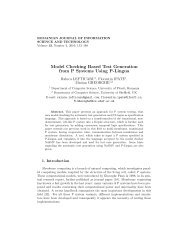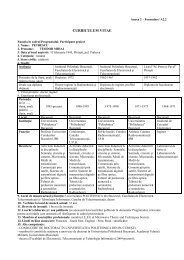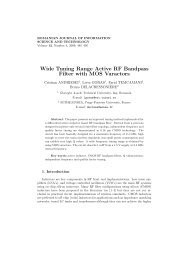Antenna on package for 60 GHz frequency band applications - IMT
Antenna on package for 60 GHz frequency band applications - IMT
Antenna on package for 60 GHz frequency band applications - IMT
- No tags were found...
Create successful ePaper yourself
Turn your PDF publications into a flip-book with our unique Google optimized e-Paper software.
Andrei A. Müller*Dan Neculoiu*Saurabh Sinha**Dan Dascalu*<str<strong>on</strong>g>Antenna</str<strong>on</strong>g> <strong>on</strong> <strong>package</strong> <strong>for</strong><strong>60</strong> <strong>GHz</strong> <strong>frequency</strong> <strong>band</strong>applicati<strong>on</strong>sandrei.muller@imt.rodan.neculoiu@imt.rossinha@ieee.orgdan.dascalu@imt.ro* Nati<strong>on</strong>al Research Institute <strong>for</strong> Microtechnologies, <strong>IMT</strong> Bucharest, Romania** Microelectr<strong>on</strong>ics & Electr<strong>on</strong>ics Group, University of Pretoria, South AfricaNati<strong>on</strong>al Research Institute <strong>for</strong> Microtechnologies, <strong>IMT</strong> Bucharest, RomaniaAcknowledgement This paper was the result of the bilateralcooperati<strong>on</strong> Romania – South Africa project FERAMI – PN II (Nati<strong>on</strong>alRomanian Authority <strong>for</strong> Research) The paper presents some results obtainedby the 1 st author during his research stagein South AfricaDepartement Elektriese, Elektr<strong>on</strong>iese & Rekenaar-IngenieursweseDepartment of Electrical, Electr<strong>on</strong>ic & Computer EngineeringKgoro ya Merero ya Mohlagase, Elektr<strong>on</strong>iki & Bointšinere bjaKhomphuthaOutlineBroad<strong>band</strong> communicati<strong>on</strong>in the <strong>60</strong> <strong>GHz</strong> <strong>band</strong>• Introducti<strong>on</strong>• The <strong>60</strong> <strong>GHz</strong> <strong>band</strong>• <strong>60</strong> <strong>GHz</strong> antennas• CMOS antennas• Possible soluti<strong>on</strong>s <strong>for</strong> <strong>60</strong> <strong>GHz</strong>antennas• Simulati<strong>on</strong> results• C<strong>on</strong>clusi<strong>on</strong>s802.15.3c IEEE standards group specificati<strong>on</strong>s <strong>for</strong> <strong>60</strong> <strong>GHz</strong> radiosA few <strong>GHz</strong> of unlicensed <strong>frequency</strong> <strong>band</strong>sTargeted data rate > 2 GbpsHigh-data-rate applicati<strong>on</strong>s wireless data bus to replace cables• Ethernet (1000Mbps), USB 2.0 (480Mbps), IEEE 1394 (~800Mbps) high-speed internet access wireless video (HDTV)1
Benefits of <strong>60</strong> <strong>GHz</strong>Unlicensed spectrum a few <strong>GHz</strong> of c<strong>on</strong>tinuously unlicensed spectrumHigh security transmissi<strong>on</strong> Oxygen absorpti<strong>on</strong>• short transmissi<strong>on</strong> distances Narrow antenna beam width (typ.4-5°)High level of <strong>frequency</strong> reusability High no. of users in a small geographical areaHigh data transmissi<strong>on</strong> speeds Gbps data ratesMature technology Spectrum used <strong>for</strong> secure communicati<strong>on</strong>s <strong>for</strong> yearsMillimeter wave antennarequirements & applicati<strong>on</strong>s <str<strong>on</strong>g>Antenna</str<strong>on</strong>g> requirements Broad<strong>band</strong> operati<strong>on</strong>• minimum 5 <strong>GHz</strong> <strong>band</strong>width High radiati<strong>on</strong> efficiency• low dielectric c<strong>on</strong>stant Low interc<strong>on</strong>nect loss with Tx/Rx chip• coplanar feed Easy integrati<strong>on</strong> into <strong>package</strong>• planar technology Applicati<strong>on</strong>s wireless gigabit ethernet ( <strong>60</strong> <strong>GHz</strong>, 80 <strong>GHz</strong> )• indoor / outdoor (point to point) automotive radar ( 77 <strong>GHz</strong> ) imaging ( 94 <strong>GHz</strong> )Package requirementsCMOS circuits <strong>for</strong> <strong>60</strong> <strong>GHz</strong> Standard planar manufacturing technology low-cost Small feature size low tolerances Accurate alignment Candidates advanced PCB• thin-film Low Temperature Cofired Ceramic (LTCC) Silic<strong>on</strong>-basedTrend towards deep sub-micr<strong>on</strong> technologies 130 nm• Razavi (2006): <strong>60</strong><strong>GHz</strong> radio transceiver chip 90 nm• Toshiya et al. (2007): <strong>60</strong> <strong>GHz</strong> receiver chip 65 nm• Var<strong>on</strong>en et al. (2007): building block circuits 45nm, 22nm• higher power gain with lower power c<strong>on</strong>sumpti<strong>on</strong> at<strong>60</strong><strong>GHz</strong>Integrated CMOS RF circuits Space, cost & power reducti<strong>on</strong>Low-costHigh per<strong>for</strong>mance2
Integrated <strong>60</strong> <strong>GHz</strong> <str<strong>on</strong>g>Antenna</str<strong>on</strong>g>s<str<strong>on</strong>g>Antenna</str<strong>on</strong>g> efficiency Integrated CMOS RF circuits <str<strong>on</strong>g>Antenna</str<strong>on</strong>g> <strong>on</strong> Chip (AoC) <str<strong>on</strong>g>Antenna</str<strong>on</strong>g> in Package (AiP) Problem: Silic<strong>on</strong> Low resistivity High permittivityVery poor radiati<strong>on</strong>efficiency and highlossesSubstrate (εr) 80-90%Dipole <strong>on</strong> chip Can be improved by substrate permittivity• different substrates• Tefl<strong>on</strong>• Low Temperature Cofired Ceramic (LTCC)• Silic<strong>on</strong> optimizing substrate thickness adding a ground plane adding a superstrateSimulati<strong>on</strong> tool setupRadiati<strong>on</strong> pattern <strong>for</strong> a ½ λ(f=<strong>60</strong> <strong>GHz</strong>) dipole antenna Zeland IE3D Based <strong>on</strong> the Method of Moments Setup Simulati<strong>on</strong> of well known antennac<strong>on</strong>figurati<strong>on</strong>s Comparis<strong>on</strong> with theoretical valuesusing the Mathematica analysis tool Starting point <strong>for</strong> the meshingparametersMathematica3 dB Beamwidth = 78.1°Input impedance = 73.13ΩDirectivity=1.641.25 mm1.25 mmZeland IE3D3 dB Beamwidth = 78.4°Input impedance = 72.76ΩDirectivity=2.143
Radiati<strong>on</strong> pattern <strong>for</strong> a 1λ(120 <strong>GHz</strong>) dipole antennaRadiati<strong>on</strong> pattern <strong>for</strong> a 3/2 λ(180 <strong>GHz</strong>) dipole antenna3 dB Beamwidth = 47.<strong>60</strong>°(<strong>for</strong> the maximum radiati<strong>on</strong>directi<strong>on</strong>)Input impedance = 105.41 ΩDirectivity=3.46353MathematicaMathematica3 dB Beamwidth = 47.84°Input impedance = very highDirectivity=2.41Zeland IE3D3 dB Beamwidth = 49°Input impedance = 352ΩDirectivity=3.71Zeland IE3D3 dB Beamwidth = 47°(<strong>for</strong> the maximum radiati<strong>on</strong>directi<strong>on</strong>)Input impedance = 104.3ΩDirectivity=3.46Next step… After obtaining a good agreementbetween theory and simulati<strong>on</strong> IE3D simulati<strong>on</strong>s <strong>for</strong> variousc<strong>on</strong>figurati<strong>on</strong>s• Purpose: radiati<strong>on</strong> efficiencymaximizati<strong>on</strong>Different dielectricsubstrates and heightsRadiati<strong>on</strong> efficiency in air/ radiati<strong>on</strong> efficiency <strong>on</strong> substrateEfficiency ratioSubstrate thickness (156÷1250µm)x λ0@<strong>60</strong><strong>GHz</strong> lower substrate εr higher (Pr,air)average Power dissipated in the substrate > Power dissipated in air4
Ground plane & superstrateGround plane & superstrateZeland IE3D: radiati<strong>on</strong> efficiency of the antenna <strong>for</strong> εsubstrate=11.7Zeland IE3D: radiati<strong>on</strong> efficiency of the antenna <strong>for</strong> εsubstrate=211.7+ground2+groundEfficiency11.711.7+dielectric+groundEfficiency22+dielectric+groundSubstrate thickness (156÷1250µm)x λ0@<strong>60</strong><strong>GHz</strong>Ground plane radiati<strong>on</strong> efficiency approaches 70% (limited by the high εr)Adding a 100 µm superstrate with ε=2 doesn’t improve the radiati<strong>on</strong> efficiencySubstrate thickness (156÷1250µm)x λ0@<strong>60</strong><strong>GHz</strong>Ground plane radiati<strong>on</strong> efficiency ~100%, <strong>for</strong> a superstrate of high εrAdding a 100 µm superstrate with the dielectric permittivity of 11.7 increasesthe radiati<strong>on</strong> efficiency <strong>for</strong> specific heights of the substrateRadiati<strong>on</strong> efficiency <strong>for</strong>different c<strong>on</strong>figurati<strong>on</strong>sRadiati<strong>on</strong> efficiency inrespect to superstrate heightBest results:EfficiencyLow permittivitysubstrateSubstrate thickness:0.09 x λ0Ground planeSuperstrate of higherpermittivityEfficiencySubstrate thickness (156÷1250µm)x λ0@<strong>60</strong><strong>GHz</strong>Substrate height=312µm=0.08λ0 εr =2Superstrate height [µm]Superstrateεr =11.75
C<strong>on</strong>clusi<strong>on</strong>s Comparis<strong>on</strong> between Mathematica andZeland IE3D good agreement Zeland IE3D offers c<strong>on</strong>trol over almost allantenna parameters needed <strong>for</strong> the design Radiati<strong>on</strong> efficiency <strong>for</strong> differentc<strong>on</strong>figurati<strong>on</strong>s of a <strong>60</strong> <strong>GHz</strong> λ/2 dipole The superstrate effect <strong>on</strong> different substrates• Increase of the radiati<strong>on</strong> efficiency <strong>for</strong> low substratepermittivity and higher superstrate permittivity• Dependent <strong>on</strong> substrate and superstrate height The presence of a ground plane improves theradiati<strong>on</strong> efficiency substantiallyThank you <strong>for</strong> yourattenti<strong>on</strong>!6


